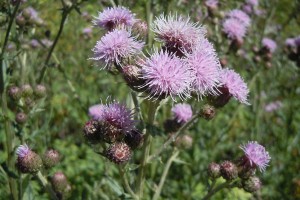Californian thistle gall fly
History in New Zealand
Californian thistle gall flies are native to Europe, and they were first imported from Switzerland and Canada (where they have also been used as a biological control agent) by the DSIR in 1975. Small numbers of flies were released at 12 sites. Damaged thistles were seen at one release site for a number of years but the flies appeared to slowly die out and no sign of them was seen after 1985. A second attempt was made to establish this agent when Landcare Research imported shipments of flies from Canada in 1994 and the USA in 1996. The progeny of these shipments have been released at a limited number of sites and the flies have established but are not yet common or widespread.
How would I find/recognise it and what is its lifecycle?
The adults emerge in the spring and you may see these distinctive-looking flies resting on thistles through into the summer. The flies are about 5-8 mm long and their bodies are black. They have clear wings with a striking black W- shaped marking on each one.

Image: Californian thistle gall fly (Urophora cardui).

Image: Californian thistle gall fly (Urophora cardui).
The females use their long black ovipositors to lay eggs in the terminal and lateral shoots of Californian thistle plants. The eggs hatch after 4-8 days into whitish larvae that burrow into the stem tissue. The larvae feed here and prompt the plant to producing a swelling made of hard tissue called a gall.

Image: Californian thistle gall fly gall.
The galls are initially green, but turn brown later as they mature. Galls start to show up in late summer but are most easily seen in the autumn. The galls become bigger as the larvae grow, and they can reach several centimetres across. If you use a knife to cut a gall open, then you will be able to see between 1-30 creamy-coloured maggots inside. When the thistles die back in the autumn the galls fall to the ground and gradually rot over the winter. Once air gets inside, the larvae are triggered to pupate. The pupae are reddish-brown, and the insect remains in this phase for about 24-25 days, before new adults emerge to begin the cycle again.
Two closely related gall flies, the nodding thistle gall fly (Urophora solstitialis) and the Scotch thistle gall fly (Urophora stylata) have been released to attack other thistles in New Zealand The Scotch thistle gall fly prefers Scotch thistle (Cirsium vulgare) but may occasionally attack the flowerheads of Californian thistle. Only the Californian thistle gall fly will cause vegetative galls to form on Californian thistles.
See Nodding thistle gall fly, Scotch thistle gall fly.
How does it damage Californian thistle?
The plant is tricked into diverting valuable nutrients, which would normally be used for plant growth and increasing root reserves, into the galls to feed the developing larvae. Terminal galls are more damaging to the plant than lateral galls as they stop bud production and significantly reduce stem height.

Image: Californian thistle gall fly galls.
Will it attack other plants?
No, this agent will not attack other plants. Even other thistle species are not harmed.
How effective is it?
The impact of Californian thistle gall fly has not yet been measured in New Zealand. However, given that the galls are commonly eaten by stock it is not expected that this agent will be able to contribute much to Californian thistle control in most settings.
How can I get the most out of it?
If Californian thistle gall fly is not yet present in your area, and the thistles will not be exposed to stock grazing, you can accelerate dispersal by shifting some from an established site.
How do I select a release site?
Read Guidelines for selecting release sites for biocontrol agents.
How do I collect it for release at other sites?
You need to collect galls once they have dried off in late autumn and release between 50 and 100. We recommend that you put the galls in an onion bag or similar - something that is strong enough to last the winter, that has holes in it large enough to let the flies get out in the spring, but are not so large that the galls fall out. Tie the bags securely off the ground (so mice cannot get them).
Key contact



